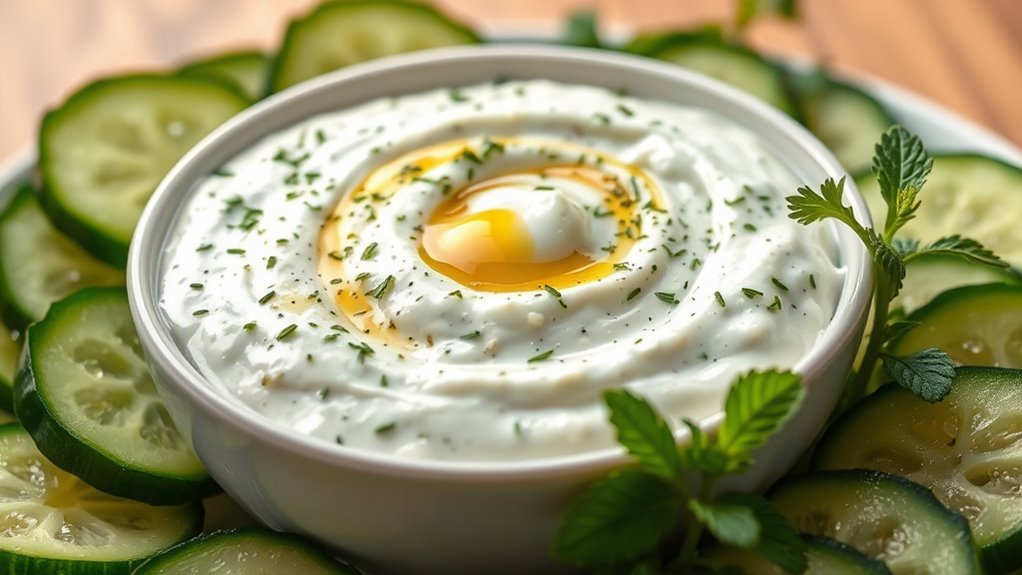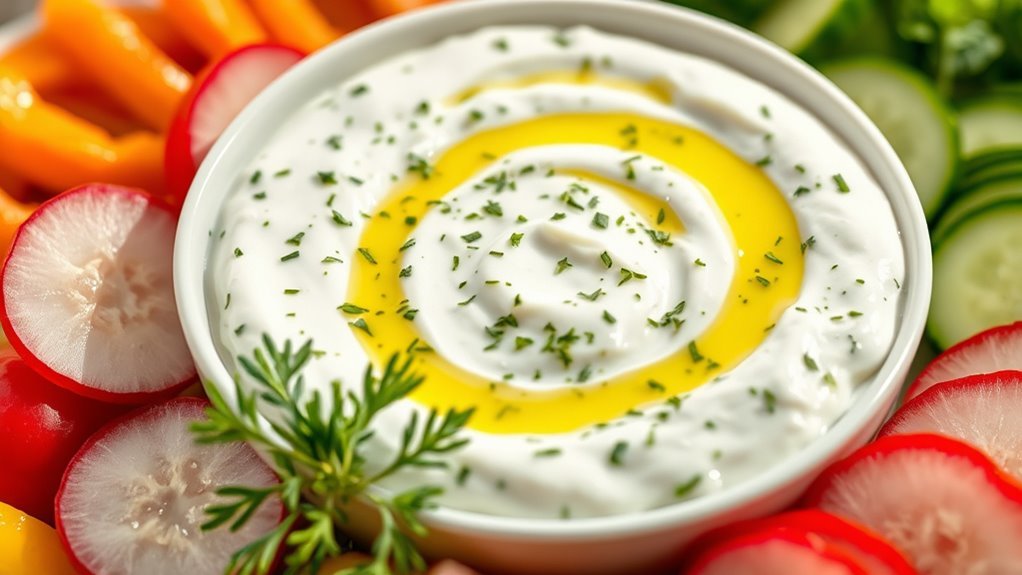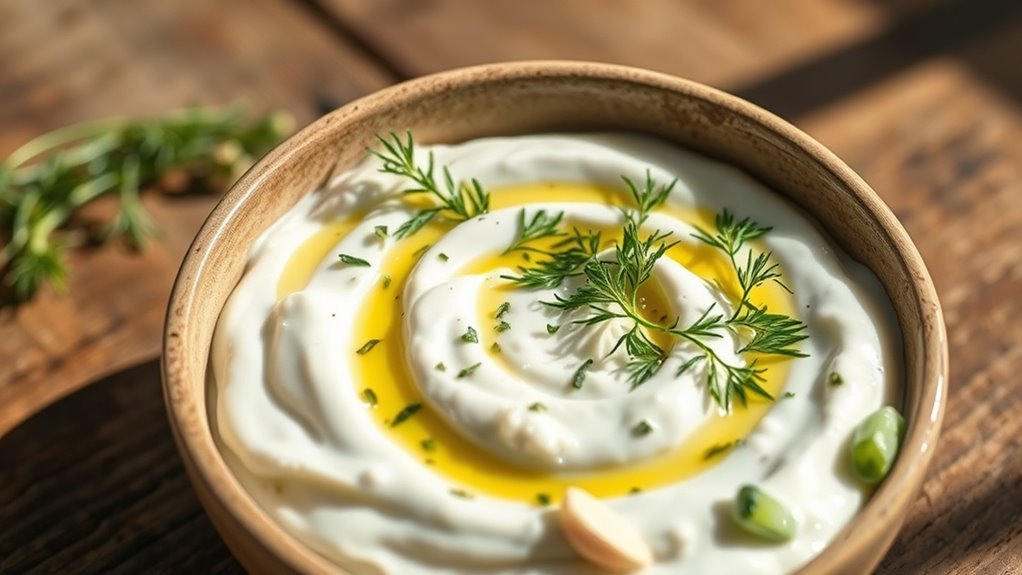Yes, tzatziki is keto-friendly! This delicious dip is low in carbs, with about 3-4 grams per serving. It’s made from yogurt, cucumbers, and garlic, packed with nutrients and probiotics that support gut health. You can use tzatziki as a dip for fresh veggies or a flavorful accompaniment to grilled meats. It enhances meals without adding significant carbs. Curious about how to incorporate it into your keto diet? There’s more to discover!
Understanding the Ingredients of Tzatziki

Tzatziki, a revitalizing Greek sauce, primarily consists of yogurt, cucumbers, garlic, olive oil, and herbs like dill or mint. Each of these tzatziki ingredients contributes to its unique flavor and health benefits. Yogurt serves as a probiotic powerhouse, promoting gut health. Cucumbers, often overlooked, are hydrating and low in calories, making them a great addition for anyone seeking to maintain a healthy lifestyle. They’re rich in vitamins and antioxidants, which can enhance skin health. Garlic provides antimicrobial properties, while olive oil adds heart-healthy fats. The herbs not only elevate the taste but also offer additional nutritional perks. Understanding these ingredients helps you appreciate tzatziki’s role in a balanced diet, aligning with your quest for freedom in food choices.
Nutritional Breakdown of Tzatziki

When considering the nutritional value of tzatziki, you’ll find it to be a surprisingly healthy option. This creamy dip is primarily made from Greek yogurt, cucumbers, garlic, and herbs, offering a low-calorie, nutrient-dense choice. Tzatziki is rich in protein and probiotics, which can boost gut health—one of its key tzatziki health benefits. A typical serving contains essential vitamins like vitamin A and C, along with minerals like calcium. For those on a keto diet, you can enjoy tzatziki with various serving suggestions, such as pairing it with raw veggies, grilled meats, or as a sauce in lettuce wraps. It’s a versatile condiment that enhances flavor while supporting a balanced diet.
Is Tzatziki Low in Carbs?

For those following a keto diet, understanding the carbohydrate content of tzatziki is key. Generally, tzatziki is low in carbs, making it a suitable choice for your meal plan. A typical serving contains about 3-4 grams of carbohydrates. This can vary slightly based on the tzatziki recipes you use, especially if you add ingredients like garlic or herbs.
Here’s a quick breakdown of tzatziki’s carb content:
| Ingredient | Carb Content (per 100g) |
|---|---|
| Greek Yogurt | 3.6g |
| Cucumber | 3.1g |
| Garlic (optional) | 33g |
Keto-Friendly Alternatives to Traditional Tzatziki
If you’re looking to enjoy tzatziki while sticking to a keto lifestyle, several alternatives can help you maintain low carb counts without sacrificing flavor. For cucumber alternatives, consider using zucchini or shredded radishes; both provide a similar crunch with fewer carbs. When it comes to yogurt substitutes, opt for full-fat Greek yogurt or even sour cream, as they have lower carb content than traditional yogurt. You might also experiment with coconut yogurt, ensuring it’s unsweetened to keep carbs in check. Adding herbs like dill and mint can enhance the taste and keep it authentic. These simple swaps allow you to relish tzatziki while adhering to your keto goals, giving you the freedom to enjoy delicious flavors without compromising your diet.
How to Incorporate Tzatziki Into Your Keto Diet
Incorporating tzatziki into your keto diet can be both enjoyable and beneficial. You can use it in various ways to serve, enhancing your meals without piling on carbs. Try it as a dip for fresh veggies like cucumber, bell peppers, or celery sticks. It also pairs wonderfully with grilled meats, such as chicken or lamb, adding a revitalizing flavor that complements the richness of the protein. For a quick snack, spread tzatziki on a low-carb wrap with turkey or lettuce. You can even drizzle it over salads for a creamy dressing alternative. By experimenting with these meal pairings, you’ll discover that tzatziki is not just keto-friendly but a versatile addition to your culinary repertoire.
Frequently Asked Questions
Can I Use Greek Yogurt in Keto Tzatziki Recipes?
Imagine a sun-kissed garden, where Greek yogurt blooms like a vibrant flower, rich in benefits. Yes, you can absolutely use Greek yogurt in keto tzatziki recipes! Its creamy texture adds depth while being low in carbs, fitting perfectly into your keto lifestyle. You can explore various keto tzatziki variations by blending in fresh herbs and spices, creating a delightful dip that satisfies your cravings without sacrificing your freedom to enjoy tasty, healthy foods.
How Long Does Homemade Tzatziki Last in the Fridge?
Homemade tzatziki typically lasts about 3 to 5 days in the fridge, depending on the ingredients used. To maximize its shelf life, store it in an airtight container. Keep it away from moisture to prevent spoilage. If you notice any off smells or changes in texture, it’s best to discard it. Following these storage tips guarantees you can enjoy your tzatziki while it’s fresh and flavorful!
Is Tzatziki Suitable for Dairy-Free Diets?
If you’re following a dairy-free diet, traditional tzatziki isn’t suitable since it’s made with yogurt. However, you can easily create a delicious vegan tzatziki using dairy alternatives like coconut yogurt or cashew yogurt. These substitutes maintain the creamy texture and flavor while keeping it dairy-free. Just mix in cucumber, garlic, and herbs, and you’ll have a revitalizing dip that fits your dietary needs perfectly. Enjoy your freedom to indulge without dairy!
Can I Freeze Tzatziki for Later Use?
Did you know that about 30% of food is wasted globally? If you’re looking to minimize waste, you might wonder if you can freeze tzatziki for later use. While you can freeze it, be aware that the texture may change; it can become watery or grainy upon thawing. To preserve it better, consider using proper freezing methods, like storing it in airtight containers. Just remember to stir well after thawing to help restore its consistency.
What Herbs Can I Add to Enhance Tzatziki Flavor?
To enhance tzatziki’s flavor, consider incorporating fresh herb combinations like dill, mint, or parsley. These herbs not only add freshness but also depth to the dish. You can also experiment with flavor enhancement techniques such as adding a squeeze of lemon juice or a pinch of garlic. These additions can elevate your tzatziki, making it more vibrant and enjoyable. Don’t hesitate to adjust according to your taste preferences for the ultimate experience!


